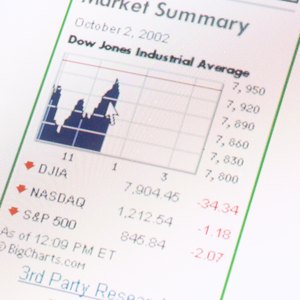
Price-weighted indices display the average value of a stock without regard to the number of shares purchased or the magnitude of the stock's price. Changes in a price-weighed index allow you to track increases or decreases in the index. And from this information you may derive its rate of return. This rate may be calculated as a period return or annualized to compare with the annual rates of return of other investments.
Divide the current price-weighted index with its previous value. As an example, on Sept. 21, 2011 the Dow Jones Industrial Average was $11,124.84. On Sept. 9, 2011 it was $10,992.13. Dividing the first value by the second gives you a multiplier of 1.01856. If you only wanted to calculate the period rate of return, subtract 1 from this figure to get 0.01856, or 1.856 percent. However, to compare with other investments, you need to annualize the multiplier.
Divide 365 by the number of days between the calculated price-weighted indices. This calculates the fraction of a year between values. In the example, there are 12 days between the calculated index values, so you divide 365 by 12 to get 30.42.
Raise the multiplier, calculated in Step 1, to the power of the fraction of the year, calculated in Step 2. In the example, this gives you an annualized multiplier of 1.7495.
Subtract 1 to get the annualized rate of return. In the example, subtracting one gives you an annualized rate of return of 0.7495, or 74.95 percent. This is an extraordinary return -- but don't count on it. Market fluctuations make rates of return calculated from such short time spans unreliable. For greater accuracy, you would want a lengthy time span between index calculations.
References
Writer Bio
C. Taylor embarked on a professional writing career in 2009 and frequently writes about technology, science, business, finance, martial arts and the great outdoors. He writes for both online and offline publications, including the Journal of Asian Martial Arts, Samsung, Radio Shack, Motley Fool, Chron, Synonym and more. He received a Master of Science degree in wildlife biology from Clemson University and a Bachelor of Arts in biological sciences at College of Charleston. He also holds minors in statistics, physics and visual arts.

